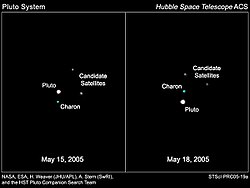Nix (moon)
From Wikipedia, the free encyclopedia

The highest definition image of Nix, imaged byNew Horizons on 14 July 2015. Image captured in grayscale by LORRI, color added based other images from Ralph MVIC.
| |
| Discovery | |
|---|---|
| Discovered by | Hubble Space Telescope Pluto Companion Search Team |
| Discovery date | 15 June 2005 |
| Designations | |
| Pronunciation | /ˈnɪks/ |
Named after
| Nyx |
| (134340) Pluto II[1] | |
| Adjectives | Nictian |
| Orbital characteristics[3] | |
| 48694±3 km | |
| Eccentricity | 0.00000[2] |
| 24.85463±0.00003 d | |
| Inclination | 0.133°±0.008° |
| Satellite of | Pluto |
| Physical characteristics | |
| Dimensions | 54 km × 41 km × 36 km[2][4] |
| Mass | (4.5±4.0)×1016 kg[2] |
1.829 d[4] (July 2015)
chaotic[5] (increased by 10% between discovery and flyby)[4] | |
| 132°[4] (to orbital plane; July 2015) | |
| Albedo | 0.43 to 0.50 mean observed geometric |
| Temperature | 33–55 K |
| 23.38–23.7 (measured)[6] | |
Nix is a natural satellite of Pluto. It was discovered along with Hydra (Pluto's outermost satellite) in June 2005. It was imaged along with Pluto and its other moons by the New Horizons spacecraft as it flew by the Pluto system in July 2015.[7] Of the four small Plutonian moons the best pictures are of Nix, with resolutions as high as 330 meters per pixel.[8]
Contents
[hide]History[edit]
Discovery[edit]
Nix was found by the Hubble Space Telescope Pluto Companion Search Team, composed of Hal A. Weaver, Alan Stern, Max J. Mutchler, Andrew J. Steffl, Marc W. Buie, William J. Merline, John R. Spencer, Eliot F. Young, and Leslie A. Young. The discovery images were taken on 15 May 2005 and 18 May 2005. Nix and Hydra were independently discovered by Max J. Mutchler on 15 June 2005 and by Andrew J. Steffl on 15 August 2005. The discoveries were announced on 31 October 2005, after confirmation by precoveries from 2002. They were provisionally designated S/2005 P 1(Hydra) and S/2005 P 2 (Nix) and casually referred to as "P1" and "P2", respectively.[9][10]
Name[edit]
The formal name "Nix", from the Greek goddess of darkness and night and mother of Charon (ferryman of Hades), was announced on 21 June 2006 on IAU Circular 8723,[9] where the designation Pluto II is also given. The initials N and H, for Nix and Hydra, come from "New Horizons". The original proposal was to use the classical spelling Nyx, but to avoid confusion with the asteroid 3908 Nyx, the spelling was changed to Nix. Jürgen Blunck explains it as the "Spanish translation" of the Greek name.[11]
Orbit and rotation[edit]
Nix follows a circular orbit in the same plane as Charon.[2] It is in a 3:2 orbital resonance with Hydra, and a 9:11 resonance with Styx(the ratios represent numbers of orbits completed per unit time; the period ratios are the inverses).[3][12] As a result of this "Laplace-like" 3-body resonance, it has conjunctions with Styx and Hydra in a 2:3 ratio.
Its orbital period of 24.9 days is also close to a 1:4 orbital resonance with Charon, but the timing discrepancy is 2.8%; there is no active resonance.[3][13] A hypothesis explaining such a near-resonance is that it originated before the outward migration of Charon following the formation of all five known moons, and is maintained by the periodic local fluctuation of 9% in the Pluto–Charon gravitational field strength.
As with Hydra and perhaps the other small Plutonian moons, Nix tumbles chaotically; the moon's axial tilt and day length vary greatly over short timescales.[14][15] At the time of New Horizon's flyby, Nix was rotating with a period of 43.9 hours retrograde to Pluto's equator with an inclination of 132 degrees — in other words it is rotating "backwards" in relation to its orbit around Pluto.[16] The rotation period has actually increased by 10% since Nix was discovered.[16]
Physical characteristics[edit]
Nix has been measured to be 54 by 41 by 36 kilometers (33.6 mi × 25.5 mi × 22.4 mi) in diameter, indicating a very elongated shape, and a very high geometric albedo.[2] In the discovery image, Nix is 6,300 times fainter than Pluto.[17] New Horizons determined that Nix is approximately 32 kilometers (20 mi) across.[18]
Early research appeared to show that Nix was reddish like Pluto and unlike the other moons,[13] but more-recent reports have been that it is grey like the remaining satellites.[6]New Horizons spotted a large region with a distinctive red tint surrounding a large crater, which may explain these conflicting results.[19] Detailed images of the moon have revealed at least 6 impact craters on it, the largest of which is about 15 km across.
Exploration[edit]
| This section requires expansion.(July 2015) |
New Horizons is the only spacecraft that has flown through the Pluto system and hence the only one that has explored Nix. Until 13 July 2015, when NASA's Long Range Reconnaissance Imager on board New Horizons determined Nix's size,[18] all but its existence was unknown. Of Pluto's smaller satellites, it was the only one clearly imaged.





